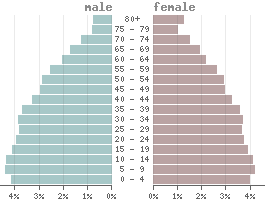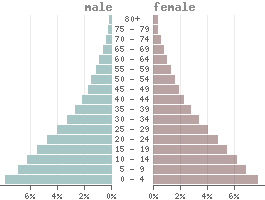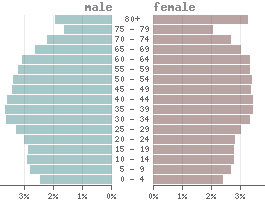Comparison: Population growth by country
Global population growth is the result of birth rate and death rate. The world population is rising steadily. In 2021, it reached a total population of 7.888 billion people on our planet with a growth rate of 0.9%.With a growth rate of about 0.7% in the last decade, the United States is well in the middle of the global comparison. The last slight increase in it’s growth rate was in 90s.By contrast, the countries of Qatar and Oman (both in the Middle East) have led the field by far in recent decades. Here, growth rates of over 10% per year were achieved in some cases, although growth rates have already started to decline in recent years.
The table shows the growth or demographic decline in 107 countries in the years 2012 to 2021. By far, the strongest growth was in Equatorial Guinea, averaging 5.28% per year. This corresponds to a doubling of the population in less than 14 years. Overall, it is striking that these extremely high growth rates occur more frequently in small states of the Middle East and are associated with an above-average birth rate and an low mortality rate. The explanation for this lies in the very small proportion of older population strata. Older residents from 55 years are virtually non-existent and by far the largest population is between 25 and 54 years old.Another cluster of states with increased population growth occurs in Central and South Africa. The reason is the exceptionally high birth rate, which is sometimes over 50‰ (=50 births per 1,000 inhabitants and year). In 2021, 46% of Central Africa’s population was under 15 years of age (cf. World Population Datasheet ).Worldwide, the average birth rate since the turn of the millennium is around 22‰. In addition, due to the aging society, there has been a noticeable decline in the overall mortality rate from about 20‰ to about 10‰ in the fast-growing countries over the past 20 years.The opposite is clear at the other end of the table, where there are disproportionately many Eastern European countries. The death rate in these countries has been higher than the birth rate in recent decades. Also in this region, churn plays a greater role than e.g., in Western European or Asian countries.Click on one of the country names in the table to see more information about each country.
In the last 2,000 years, the population increased slowly and steadily. Just 350 years ago, there were only half a billion people on earth. With the “Industrial Revolution” at the end of the 18th century, an unprecedented increase in population began. Numerous technical and chemical developments such as medicine and fertilizer dropped the death rate drastically. At the same time, there was an improved supply of food for large parts of the population, which also ensured the future of the offspring and thus led to an increased birth rate. Population growth jumped from 0.3% up to 0.8%. In the following 300 years alone, the world population grew from 0.5 to over three billion people.Considering recent times, the curve flattens off again. The following graph shows the evolution of the world population from 1960 to 2021. The exponential development of the population has subsided and the graph is almost linear. There is only a minimal decline in growth rates.At the end of 2021, there were 7.89 billion people on earth. The growth rate has been at 0.86 percent.
Population pyramids: different growth by economy
The population does not rise equally in all countries. There is a striking difference when looking at the aggregated age pyramids by countries with different economic strengths. Globally, the age pyramid looks like a hive or bell with a few smaller outliers. This is due to a balanced increase in the younger generations with a birth rate of 17.2 ‰ currently and a high, late mortality, at least in relation to the entire world population.
Age pyramid world
 Low-income countries
Low-income countries
 High-income countries
High-income countries

A direct comparison of the age pyramids shows that poor and rich countries differ massively in their population growth. In rich countries, people reach old age much more frequently, which is due to a pronounced social system, above-average health care and financial stability. Not only is the number of older people increasing, but the
In poor countries, on the other hand, the age pyramid has a pagoda shape, i.e., a broadened pyramid with disproportionately rising younger cohorts. Due to higher and earlier mortality, the older inhabitants remain clearly in the minority. At the same time, there is often a lack of social systems and financial security for the population, which can thus be obtained only from within the family circle. Large families with many children also mean greater economic security in the future, which leads to an increased birth rate. In most poorer countries, family groups play a much more essential role than in rich countries. Children usually remain spatially bound for life and provide not only financial security but also care in old age.
* The marked countries are not independent and sovereign states, but dependent territories of other states. Cf. also our article
Data sources
The population does not rise equally in all countries. There is a striking difference when looking at the aggregated age pyramids by countries with different economic strengths. Globally, the age pyramid looks like a hive or bell with a few smaller outliers. This is due to a balanced increase in the younger generations with a birth rate of 17.2 ‰ currently and a high, late mortality, at least in relation to the entire world population.A direct comparison of the age pyramids shows that poor and rich countries differ massively in their population growth. In rich countries, people reach old age much more frequently, which is due to a pronounced social system, above-average health care and financial stability. Not only is the number of older people increasing, but the average age also differs considerably from that in less developed countries. At the same time, pressure to perform, high costs of living and a lack of evolutionary necessity are causing birth rates to fall. The majority of the population is now between 30 and 50 years old, while the under-20s are conspicuously underrepresented. In countries with a state pension system, this constellation will lead to fewer and fewer people having to pay for pensions financed by taxes in 10-20 years.In poor countries, on the other hand, the age pyramid has a pagoda shape, i.e., a broadened pyramid with disproportionately rising younger cohorts. Due to higher and earlier mortality, the older inhabitants remain clearly in the minority. At the same time, there is often a lack of social systems and financial security for the population, which can thus be obtained only from within the family circle. Large families with many children also mean greater economic security in the future, which leads to an increased birth rate. In most poorer countries, family groups play a much more essential role than in rich countries. Children usually remain spatially bound for life and provide not only financial security but also care in old age.* The marked countries are not independent and sovereign states, but dependent territories of other states. Cf. also our article What is a country?















![Toni Kroos là ai? [ sự thật về tiểu sử đầy đủ Toni Kroos ]](https://evbn.org/wp-content/uploads/New-Project-6635-1671934592.jpg)


